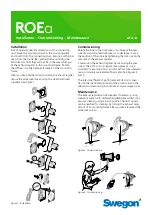
EN |
13
EIOM v2018.04
4. CABLE SELECTION AND CABLE INSTALATION
4.1 THREE PHASE RECEIVER POWER SUPPLY CABLE SELECTION
Various conditions must be evaluated before selecting cable cross-section area:
• Power;
• Current;
• Starting currents;
• Operating conditions;
• Voltage drop;
• Mounting type;
• Ambient temperature;
Current-carrying capacity of PVC insulated copper conductors or cables under steady-state conditions in an ambient air temperature of +40 °C for
different methods of installation (EN 60204-1:2006):
INSULATION METHODS
B2
C
E
Cross-sectional area, mm
2
Current-carrying capacity I for three phase circuits, A
0.75
8,5
9,8
10,4
1.0
10,1
11,7
12,4
1.5
13,1
15,2
16,1
2.5
17,4
21
22
4
23
28
30
6
30
36
37
10
40
50
52
16
54
66
70
25
70
84
88
35
86
104
110
50
103
125
133
70
130
160
171
95
156
194
207
120
179
225
240
The voltage drop from the point of supply to the load shall not exceed 5 % of the nominal voltage under normal operating conditions. In order
to conform to this requirement, it can be necessary to use conductors having a larger cross-sectional area than that derived from selection list.
Methods of conductor and cable installation independent of number of conductors/cables
Figure 4.1.1 - B2 Cables in conduit and cable
trunk systems
Figure 4.1.2 - C Cables on walls
Figure 4.1.3 - D Cables on open cable trays
4.2 POWER AND CONTROL CABLE INSTALATION
Shielded cables recommended during installation.
One end of the cable screen must be grounded at the control box ground terminal.
Power and control cables should be separated during installation (minimum distance 50 mm).
Separated cable ducts and different cable glands should be used for power and control cables.














































